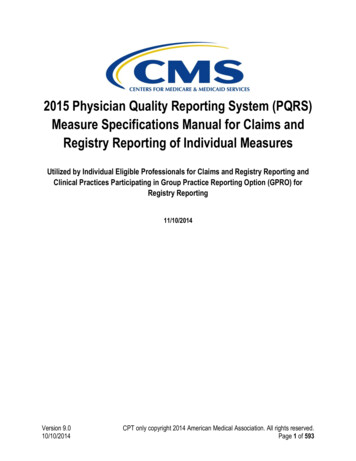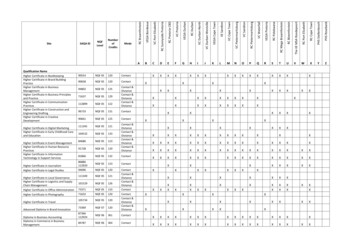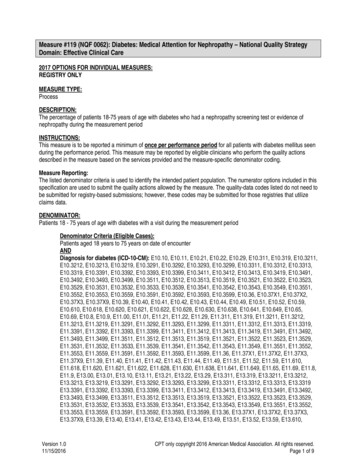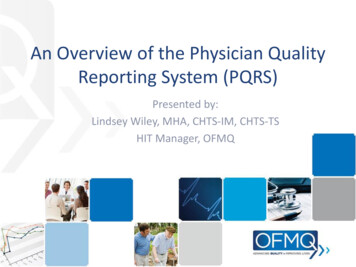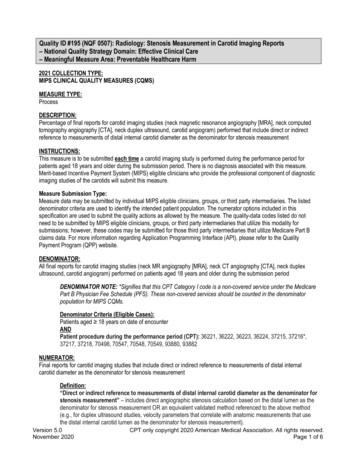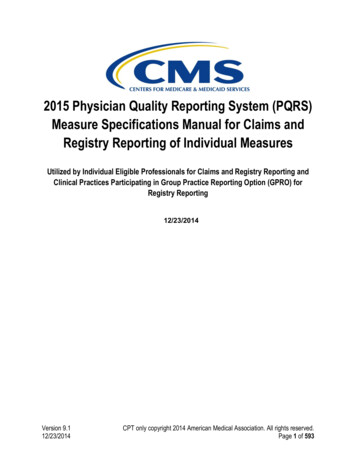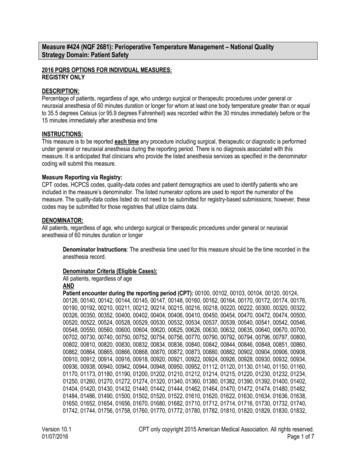
Transcription
Measure #424 (NQF 2681): Perioperative Temperature Management – National QualityStrategy Domain: Patient Safety2016 PQRS OPTIONS FOR INDIVIDUAL MEASURES:REGISTRY ONLYDESCRIPTION:Percentage of patients, regardless of age, who undergo surgical or therapeutic procedures under general orneuraxial anesthesia of 60 minutes duration or longer for whom at least one body temperature greater than or equalto 35.5 degrees Celsius (or 95.9 degrees Fahrenheit) was recorded within the 30 minutes immediately before or the15 minutes immediately after anesthesia end timeINSTRUCTIONS:This measure is to be reported each time any procedure including surgical, therapeutic or diagnostic is performedunder general or neuraxial anesthesia during the reporting period. There is no diagnosis associated with thismeasure. It is anticipated that clinicians who provide the listed anesthesia services as specified in the denominatorcoding will submit this measure.Measure Reporting via Registry:CPT codes, HCPCS codes, quality-data codes and patient demographics are used to identify patients who areincluded in the measure’s denominator. The listed numerator options are used to report the numerator of themeasure. The quality-data codes listed do not need to be submitted for registry-based submissions; however, thesecodes may be submitted for those registries that utilize claims data.DENOMINATOR:All patients, regardless of age, who undergo surgical or therapeutic procedures under general or neuraxialanesthesia of 60 minutes duration or longerDenominator Instructions: The anesthesia time used for this measure should be the time recorded in theanesthesia record.Denominator Criteria (Eligible Cases):All patients, regardless of ageANDPatient encounter during the reporting period (CPT): 00100, 00102, 00103, 00104, 00120, 00124,00126, 00140, 00142, 00144, 00145, 00147, 00148, 00160, 00162, 00164, 00170, 00172, 00174, 00176,00190, 00192, 00210, 00211, 00212, 00214, 00215, 00216, 00218, 00220, 00222, 00300, 00320, 00322,00326, 00350, 00352, 00400, 00402, 00404, 00406, 00410, 00450, 00454, 00470, 00472, 00474, 00500,00520, 00522, 00524, 00528, 00529, 00530, 00532, 00534, 00537, 00539, 00540, 00541, 00542, 00546,00548, 00550, 00560, 00600, 00604, 00620, 00625, 00626, 00630, 00632, 00635, 00640, 00670, 00700,00702, 00730, 00740, 00750, 00752, 00754, 00756, 00770, 00790, 00792, 00794, 00796, 00797, 00800,00802, 00810, 00820, 00830, 00832, 00834, 00836, 00840, 00842, 00844, 00846, 00848, 00851, 00860,00862, 00864, 00865, 00866, 00868, 00870, 00872, 00873, 00880, 00882, 00902, 00904, 00906, 00908,00910, 00912, 00914, 00916, 00918, 00920, 00921, 00922, 00924, 00926, 00928, 00930, 00932, 00934,00936, 00938, 00940, 00942, 00944, 00948, 00950, 00952, 01112, 01120, 01130, 01140, 01150, 01160,01170, 01173, 01180, 01190, 01200, 01202, 01210, 01212, 01214, 01215, 01220, 01230, 01232, 01234,01250, 01260, 01270, 01272, 01274, 01320, 01340, 01360, 01380, 01382, 01390, 01392, 01400, 01402,01404, 01420, 01430, 01432, 01440, 01442, 01444, 01462, 01464, 01470, 01472, 01474, 01480, 01482,01484, 01486, 01490, 01500, 01502, 01520, 01522, 01610, 01620, 01622, 01630, 01634, 01636, 01638,01650, 01652, 01654, 01656, 01670, 01680, 01682, 01710, 01712, 01714, 01716, 01730, 01732, 01740,01742, 01744, 01756, 01758, 01760, 01770, 01772, 01780, 01782, 01810, 01820, 01829, 01830, 01832,Version 10.101/07/2016CPT only copyright 2015 American Medical Association. All rights reserved.Page 1 of 7
01840, 01842, 01844, 01850, 01852, 01860, 01924, 01925, 01926, 01930, 01931, 01932, 01933, 01935,01936, 01951, 01952, 01961, 01962, 01963, 01965, 01966ANDAnesthesia of 60 minutes duration or longer: 4255FAND NOTMonitored Anesthesia Care (MAC): G9654NUMERATOR:Patients for whom at least one body temperature greater than or equal to 35.5 degrees Celsius (or 95.9degrees Fahrenheit) was recorded within the 30 minutes immediately before or the 15 minutes immediatelyafter anesthesia end timeNumerator Options:Performance Met:ORORAt least 1 body temperature measurement equal to orgreater than 35.5 degrees Celsius (or 95.9 degreesFahrenheit) recorded within the 30 minutes immediatelybefore or the 15 minutes immediately after anesthesiaend time (4559F)Medical Performance Exclusion:Documentation of one of the following medicalreason(s) for not achieving at least 1 body temperaturemeasurement equal to or greater than 35.5 degreesCelsius (or 95.9 degrees Fahrenheit) recorded withinthe 30 minutes immediately before or the 15 minutesimmediately after anesthesia end time (e.g., Emergencycases, Intentional hypothermia, etc.) (4559F with 1P)Performance Not Met:At least 1 body temperature measurement equal to orgreater than 35.5 degrees Celsius (or 95.9 degreesFahrenheit) recorded within the 30 minutes immediatelybefore or the 15 minutes immediately after anesthesiaend time (4559F with 8P)RATIONALE:A drop in core temperature during surgery, known as perioperative hypothermia, can result in numerous adverseeffects, which can include adverse myocardial outcomes, subcutaneous vasoconstriction, increased incidence ofsurgical site infection, and impaired healing of wounds. The desired outcome, reduction in adverse surgical effectsdue to perioperative hypothermia, is affected by maintenance of normothermia during surgery.Unintended perioperative hypothermia occurs in up to 20% of surgical patients. An observational cohort study in apediatric setting found that more than 50% of children experienced intraoperative hypothermia. Pediatric patientsundergoing major surgery were at greater risk of intraoperative hypothermia.CLINICAL RECOMMENDATION STATEMENTS:Preadmission/Preoperative RecommendationsAssessment: Assess for risk factors for perioperative hypothermia (Class I, Level C); Measure patient temperatureon admission (Class I, Level C); Determine patient’s thermal comfort level (Class I, Level C); Assess for signs andsymptoms of hypothermia (Class I, Level C); Document and communicate all risk factor assessment findings to allmembers of the anesthesia/surgical team (Class I, Level A)Version 10.101/07/2016CPT only copyright 2015 American Medical Association. All rights reserved.Page 2 of 7
Interventions: Implement passive thermal care measures (Class I, Level B); Maintain ambient room temperature ator above 24 degrees Celsius (Class I, Level C); Institute active warming for patients who are hypothermic (Class IIb,Level B); Consider preoperative warming to reduce the risk of intra/postoperative hypothermia (Class IIb, Level B)Intraoperative RecommendationsAssessment: Identify patient’s risk factors for unplanned preoperative hypothermia (Class I, Level C); Frequentintraoperative temperature monitoring should be considered in all cases (Class I, Level C); Assess for signs andsymptoms of hypothermia (Class IIb, Level C); Determine patient’s thermal comfort level (Class IIb, Level C);Document and communicate all risk factor assessment findings to all members of the anesthesia/surgical team(Class I, Level A)Interventions: Limit skin exposure to lower ambient environmental temperatures (Class I, Level C); Initiate passivewarming measures (Class I, Level C); Maintain ambient room temperature from 20-25 degrees Celsius based onAORN and architectural recommendations (Class I, Level C); Patients undergoing a procedure with an anticipatedanesthesia time greater than 30 minutes (Class I, Level C) and/or who are hypothermic preoperatively (Class I, LevelA), and/or patients at risk for hypothermia (Class I, Level C) or at increased risk for suffering its complications (ClassI, Level C) – Forced air warming should be implemented (Class I, Level A); There is evidence to suggest thatalternative active warming measures may maintain normothermia when used alone or in combination with forced airwarming (Class IIb, Level B). These warming measures include: Warmed IV fluids (Class IIa, Level B), Warmedirrigation fluids (Class IIb, Level B), Circulating water garments (Class IIb, Level B), Circulating water mattresses(Class IIb, Level B), Radiant heat (Class IIb, Level B), Gel pad surface warming (Class IIa, Level B), Resistiveheating (Class IIa, Level B) (ASPAN, 2010)Maintenance of body temperature in a normothermic range is recommended for most procedures other than duringperiods in which mild hypothermia is intended to provide organ protection (e.g., during high aortic cross-clamping)(Class I Recommendation, Level of Evidence B) (ACC/AHA, 2007)COPYRIGHT:The Measures are not clinical guidelines, do not establish a standard of medical care, and have not been tested forall potential applications.The Measures, while copyrighted, can be reproduced and distributed, without modification, for noncommercialpurposes, e.g., use by health care providers in connection with their practices. Commercial use is defined as thesale, license, or distribution of the Measures for commercial gain, or incorporation of the Measures into a product orservice that is sold, licensed or distributed for commercial gain.Commercial uses of the Measures require a license agreement between the user and the American MedicalAssociation (AMA), [on behalf of the Physician Consortium for Performance Improvement (PCPI )] or AmericanSociety of Anesthesiologists (ASA). Neither the AMA, ASA, PCPI, nor its members shall be responsible for any useof the Measures.The AMA’s, PCPI’s and National Committee for Quality Assurance’s significant past efforts and contributions to thedevelopment and updating of the Measures is acknowledged. ASA is solely responsible for the review andenhancement (“Maintenance”) of the Measures as of May 15, 2014. ASA encourages use of the Measures by otherhealth care professionals, where appropriate.THE MEASURES AND SPECIFICATIONS ARE PROVIDED “AS IS” WITHOUT WARRANTY OF ANY KIND. 2014 American Medical Association and American Society of Anesthesiologists. All Rights Reserved. ApplicableFARS/DFARS Restrictions Apply to Government Use.Limited proprietary coding is contained in the Measure specifications for convenience. Users of the proprietary codesets should obtain all necessary licenses from the owners of these code sets. The AMA, ASA, the PCPI and itsVersion 10.101/07/2016CPT only copyright 2015 American Medical Association. All rights reserved.Page 3 of 7
members disclaim all liability for use or accuracy of any Current Procedural Terminology (CPT ) or other codingcontained in the specifications.CPT contained in the Measures specifications is copyright 2004-2015 American Medical Association. LOINC copyright 2004-2015 Regenstrief Institute, Inc. SNOMED CLINICAL TERMS (SNOMED CT ) copyright 2004-2015College of American Pathologists. All Rights Reserved.Version 10.101/07/2016CPT only copyright 2015 American Medical Association. All rights reserved.Page 4 of 7
Version 10.101/07/2016CPT only copyright 2015 American Medical Association. All rights reserved.Page 5 of 7
2016 Registry Individual Measure FlowPQRS #424 NQF #2671: Perioperative Temperature ManagementPlease refer to the specific section of the Measure Specification to identify the denominator and numeratorinformation for use in reporting this Individual Measure.1. Start with Denominator2. Check Encounter Performed:a. If Encounter as Listed in the Denominator equals No, do not include in Eligible Patient Population. StopProcessing.b. If Encounter as Listed in the Denominator equals Yes, proceed to check Anesthesia of 60 Minutes orLonger.3. Check Anesthesia of 60 Minutes or Longer:a. If Anesthesia of 60 Minutes or Longer equals No, do not include in Eligible Patient Population. StopProcessing.b. If Monitored Anesthesia Care equals Yes, include in the Eligible population.4. Check Monitored Anesthesia Care:a. If Monitored Anesthesia Care equals Yes, do not include in Eligible Patient Population. StopProcessing.b. If Anesthesia of 60 Minutes or Longer equals No, include in the Eligible population.5. Denominator Population:a. Denominator population is all Eligible Patients in the denominator. Denominator is represented asDenominator in the Sample Calculation listed at the end of this document. Letter d equals 8 proceduresin the sample calculation.6. Start Numerator7. Check At Least one Body Temperature Greater Than or Equal to 35.5 Degrees Celsius (or 95.9 degreesFahrenheit) Was Recorded Within the 30 Minutes Immediately Before or the 15 Minutes Immediately AfterAnesthesia End Time:a. If At Least one Body Temperature Greater Than or Equal to 35.5 Degrees Celsius (or 95.9 degreesFahrenheit) Was Recorded Within the 30 Minutes Immediately Before or the 15 Minutes ImmediatelyAfter Anesthesia End Time equals Yes, include in Reporting Met and Performance Met.b. Reporting Met and Performance Met letter is represented in the Reporting Rate and Performance Ratein the Sample Calculation listed at the end of this document. Letter a equals 4 procedures in SampleCalculation.c. If At Least one Body Temperature Greater Than or Equal to 35.5 Degrees Celsius (or 95.9 degreesFahrenheit) Was Recorded Within the 30 Minutes Immediately Before or the 15 Minutes ImmediatelyAfter Anesthesia End Time equals No, proceed to Documentation of Medical Reason(s) for NotAchieving At Least One Body Temperature Greater Than Or Equal to 35.5 Degrees Celsius Or 95.9Degrees Fahrenheit Within the 30 Minutes immediately Before or the 15 Minutes Immediately AfterAnesthesia End Time.Version 10.101/07/2016CPT only copyright 2015 American Medical Association. All rights reserved.Page 6 of 7
8. Check Documentation of Medical Reason(s) for Not Achieving At Least One Body Temperature GreaterThan Or Equal to 35.5 Degrees Celsius Or 95.9 Degrees Fahrenheit Within the 30 Minutes immediatelyBefore or the 15 Minutes Immediately After Anesthesia End Time:a. If Documentation of Medical Reason(s) for Not Achieving At Least One Body Temperature GreaterThan Or Equal to 35.5 Degrees Celsius Or 95.9 Degrees Fahrenheit Within the 30 Minutes immediatelyBefore or the 15 Minutes Immediately After Anesthesia End Time equals Yes, include in Reporting Metand Performance Exclusion.b. Reporting Met and Performance Exclusion letter is represented in the Reporting Rate and PerformanceRate in the Sample Calculation listed at the end of this document. Letter b equals 1 procedure in theSample Calculation.c. If Documentation of Medical Reason(s) for Not Achieving At Least One Body Temperature GreaterThan Or Equal to 35.5 Degrees Celsius Or 95.9 Degrees Fahrenheit Within the 30 Minutes immediatelyBefore or the 15 Minutes Immediately After Anesthesia End Time equals No, proceed to At Least OneBody Temperature Greater Than or Equal to 35.5 Degrees Celsius (or 95.9 Degrees Fahrenheit) NotAchieved Within the 30 Minutes Immediately Before or the 15 Minutes Immediately After AnesthesiaEnd Time.9. Check At Least One Body Temperature Greater Than or Equal to 35.5 Degrees Celsius (or 95.9 DegreesFahrenheit) Not Achieved Within the 30 Minutes Immediately Before or the 15 Minutes Immediately AfterAnesthesia End Time:a. If At Least One Body Temperature Greater Than or Equal to 35.5 Degrees Celsius (or 95.9 DegreesFahrenheit) Not Achieved Within the 30 Minutes Immediately Before or the 15 Minutes ImmediatelyAfter Anesthesia End Time equals Yes, include in Reporting Met and Performance Not Met.b. Reporting Met and Performance Not Met letter is represented in the Reporting Rate and PerformanceRate in the Sample Calculation listed at the end of this document. Letter c equals 2 procedures in theSample Calculation.c. If At Least One Body Temperature Greater Than or Equal to 35.5 Degrees Celsius (or 95.9 DegreesFahrenheit) Not Achieved Within the 30 Minutes Immediately Before or the 15 Minutes ImmediatelyAfter Anesthesia End Time equals No, proceed to Reporting Not Met.10. Check Reporting Not Met:a. If Reporting Not Met equals No, Quality Data Code or equivalent not reported. 1 procedure has beensubtracted from the reporting numerator in the sample calculation.Version 10.101/07/2016CPT only copyright 2015 American Medical Association. All rights reserved.Page 7 of 7
measure. It is anticipated that clinicians who provide the listed anesthesia services as specified in the denominator coding will submit this measure. Measure Reporting via Registry: CPT codes, HCPCS codes, quality-data codes and patient demographics are used to identify patients who are included in the measure's denominator.
